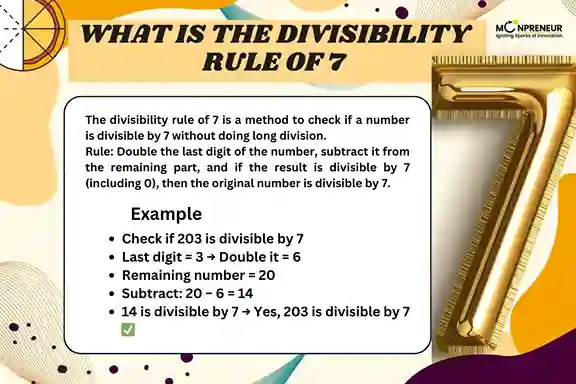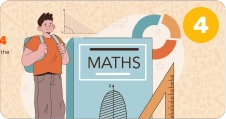Introduction
The divisibility rule of 7 is a quick math trick that helps you check whether a number is divisible by 7 without actually performing a long division. This rule is particularly useful in mental math, competitive exams, and problem-solving. While it’s not as simple as rules for 2, 5, or 10, with a little practice, you can apply it easily. Let’s explore the definition, step-by-step process, and examples to master this rule.
What is the Divisibility Rule of 7?

The divisibility rule of 7 states:
A number is divisible by 7 if, after doubling the last digit and subtracting it from the rest of the number, the result is divisible by 7.
If the result is 0 or a multiple of 7, then the original number is divisible by 7.
Step-by-Step Process to Apply the Divisibility Rule of 7
- Take the last digit of the number.
- Double it (multiply by 2).
- Subtract this doubled value from the remaining digits of the number.
- If the result is divisible by 7 (including 0), then the original number is divisible by 7.
- If the result is still large, repeat the process.
Examples of Divisibility by 7
Example 1: Check if 203 is divisible by 7.
- Last digit = 3
- Double it: 3 × 2 = 6
- Remaining number = 20
- Subtract: 20 − 6 = 14
- Since 14 is divisible by 7, 203 is divisible by 7.
Example 2: Check if 532 is divisible by 7.
- Last digit = 2
- Double it: 2 × 2 = 4
- Remaining number = 53
- Subtract: 53 − 4 = 49
- Since 49 is divisible by 7, 532 is divisible by 7.
Example 3: Check if 715 is divisible by 7.
- Last digit = 5
- Double it: 5 × 2 = 10
- Remaining number = 71
- Subtract: 71 − 10 = 61
- 61 is not divisible by 7, so 715 is not divisible by 7.
Why Learn the Divisibility Rule of 7?
- Quick calculations: Avoid long division in exams.
- Improves mental math: Sharpens number sense.
- Useful in competitive exams: Saves time in problem-solving.
- Enhances number pattern skills: Helps in understanding factors and multiples.
Divisibility Rule of 7 Chart for Quick Reference
| Number | Step 1 | Step 2 | Step 3 (Result) | Divisible by 7? |
|---|---|---|---|---|
| 203 | 3 × 2 = 6 | 20 − 6 = 14 | 14 ÷ 7 = 2 | ✅ Yes |
| 532 | 2 × 2 = 4 | 53 − 4 = 49 | 49 ÷ 7 = 7 | ✅ Yes |
| 715 | 5 × 2 = 10 | 71 − 10 = 61 | Not divisible | ❌ No |
Key Takeaways
- The divisibility rule of 7 is a simple subtraction-based trick.
- If the final result after applying the rule is divisible by 7, so is the original number.
- Repeat the steps if the number is large until you can check easily.
Conclusion
The divisibility test for 7 may seem tricky at first, but with a little practice, it becomes an effortless math skill. Whether you’re preparing for an exam or improving your mental calculation abilities, this rule is a valuable tool in your number toolkit.
Want to spark your child’s interest in math and boost their skills? Moonpreneur’s online math curriculum stands out because it engages kids with hands-on lessons, helps them apply math in real-life situations, and makes learning math exciting!
You can opt for our Advanced Math or Vedic Math+Mental Math courses. Our Math Quiz for grades 3rd, 4th, 5th, and 6th helps in further exciting and engaging in mathematics with hands-on lessons.
Related Blogs:
How to Teach Adjacent Angles to Kids | Simple & Fun Guide
What are Congruent Angles?
Understanding Alternate Interior Angles
What is the Area of Trapezoid?
What is the Area of Parallelogram?
Understanding the Geometry Regents: A Comprehensive Guide
How to Prepare for the Geometry Regents: Study Plans & Practice
The Art of Geometry: How to Draw an Equilateral Triangle Inside a Circle
















